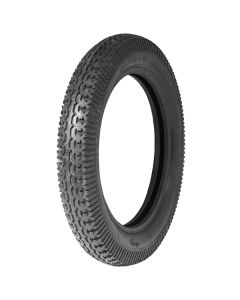Riley 9 Tyres

1931 Riley 9
Riley 9 1926–1938
- The Riley 9 fitted a 400/450 - 19 tyre.
- In this size the best performance tyre is the 4.00/4.50 x 19 Michelin D.R, it is an extremely well built tyre, designed to improve the performance of vintage cars.
- The Riley 9 fitted tube-type wheels throughout its production run, innertubes are required for the wheels to function.
- The Michelin 19MFR Central Valve is the tube best suited to the Michelin 4.00/4.50X19.
- If you are looking for a cheaper tyre then our very own 4.00/4.50 x 19 Longstone is a great option. Offering light, sporty handling and an S speed rating, this tyre is both good value and good fun!
- We suggest either the Michelin Kleber Offset Valve innertube, or the Michelin 19MFR Central Valve innertube for the Longstone, depending on your wheel type.
History of the Riley 9
The Vintage Riley Nine was among the most popular light automobiles made by the British automotive industry during the interwar period. Between 1926 and 1938, Riley of Coventry produced it in a variety of body shapes. Percy and Stanley Riley, two of the Riley brothers, created the automobile in substantial part. Stanley was in charge of the chassis, suspension, and body, while Percy designed the engine. Why do older brothers always seem to have the best jobs?
The 1087 cc four-cylinder engine had hemispherical combustion chambers and valves angled at 45 degrees in a crossflow head. To save the cost and complexity of overhead camshafts, the valves were controlled by two camshafts located high in the crankcase through short pushrods and rockers. The engine was held in place in the chassis by a rubber bushed bar that ran through the block, with an additional mount at the back of the gearbox. The drive was sent to the rear wheels through a torque tube and spiral bevel live rear axle set on semi-elliptic springs, like with all the greatest automobiles.
When it first appeared in July 1926, it came in two body styles: a fabric-bodied saloon named the Monaco and a fabric four-seat tourer. The saloon had a top speed of 60 miles per hour. The San Remo, artillery wheeled basic saloon and a 2-seater plus dickie open tourer were soon added, as was the choice of steel panelling rather of fabric for the four-seater tourer.
Production of the Mark 1 began in 1927 at Percy Riley's engine facility. It was such a critical success that Riley promptly discontinued side-valve manufacture and prepared for the new Nine in early 1928 after less than 1000 had been made. This shift to the main factory coincided with other Mark 1 improvements, including the removal of the cone clutch, moving the gear lever and handbrake from the right to the centre of the car, and the adoption of a Riley steering box, resulting in the Mark II. At the end of 1928, the Mark III was a moderate upgrade of the II, with stronger wheels and a revised arrangement of rods to the rear brakes.
The Mark IV was a comprehensive overhaul of the Nine, with sturdier Riley built 6-stud axles replacing the purchased 5-stud rod brake components, and a new cable braking system with larger drums incorporated. The choice of bodywork was expanded further in 1929 with the introduction of the Biarritz saloon, a premium version of the Monaco. The Riley continuous cable system was used to install the upgraded brakes, and if the cable stretched, it could be changed from the driver's seat.




















